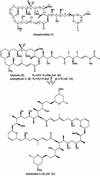Seaweed resistance to microbial attack: a targeted chemical defense against marine fungi
- PMID: 12756301
- PMCID: PMC165804
- DOI: 10.1073/pnas.1131855100
Seaweed resistance to microbial attack: a targeted chemical defense against marine fungi
Abstract
Pathogenic microbes can devastate populations of marine plants and animals. Yet, many sessile organisms such as seaweeds and sponges suffer remarkably low levels of microbial infection, despite lacking cell-based immune systems. Antimicrobial defenses of marine organisms are largely uncharacterized, although from a small number of studies it appears that chemical defenses may improve host resistance. In this study, we asked whether the common seaweed Lobophora variegata is chemically defended against potentially deleterious microorganisms. Using bioassay-guided fractionation, we isolated and characterized a 22-membered cyclic lactone, lobophorolide (1), of presumed polyketide origin, with sub-microM activity against pathogenic and saprophytic marine fungi. Deterrent concentrations of 1 were found in 46 of 51 samples collected from 10 locations in the Bahamas over a 4-year period. Lobophorolide (1) is structurally unprecedented, yet parts of the molecule are related to tolytoxin, the scytophycins, and the swinholides, macrolides previously isolated from terrestrial cyanobacteria and from marine sponges and gastropods. Until now, compounds of this structural class have not been associated with marine macrophytes. Our findings suggest that seaweeds use targeted antimicrobial chemical defense strategies and that secondary metabolites important in the ecological interactions between marine macroorganisms and microorganisms could be a promising source of novel bioactive compounds.
Figures



References
-
- Rheinheimer, G. (1992) Aquatic Microbiology (Wiley, New York), 3rd Ed.
-
- Taylor, D. L. (1983) Mar. Ecol. 4, 321–328.
-
- Smith, G. W., Ives, L. D., Nagelkerken, I. A. & Ritchie, K. B. (1996) Nature 383, 487.
-
- Littler, M. M. & Littler, D. S. (1995) Science 267, 1356–1360. - PubMed
-
- Goff, L. J. & Glasgow, J. C. (1980) Pathogens of Marine Plants, Special Publication 7 (Center for Coastal Studies, University of California, Santa Cruz).
Publication types
MeSH terms
Substances
LinkOut - more resources
Full Text Sources
Other Literature Sources

